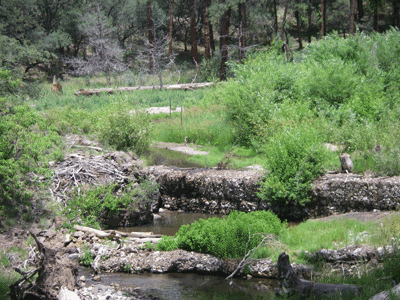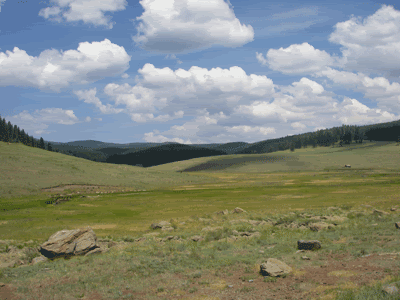Gila and Apache Trip - AZ and NM
Last summer I went out to the Southwest looking to catch an Apache trout and a Rio Grande Cutt and came back empty handed. Last weekend I went back, although this time I had a Gila and an Apache in my cross hairs.
New Mexico has recently introduced limited angling opportunities for Gila Trout. This is the first time since 1966 that there has been an opportunity to catch Gila Trout. There are a few streams that are open, but the two main streams are Iron Creek (the same Iron Creek fished by Robert H. Smith) and Black Canyon Creek (site of the infamous Diamond Bar Allotment). Iron Creek requires a long hike to get to the Gila that are above a barrier. I am told the barrier is about 3 miles upstream from where the trail from first meets Iron Creek, which is 3 miles from the trailhead, thus creating at a minimum a 6 mile walk each way to have a shot at a Gila trout. Black Canyon Creek, on the other hand, crosses a forest road and the the fish barrier is right at the road crossing. Normally I would not shy away from the hike, but I had heard a report from someone that fished Iron Creek and failed to catch a Gila, so I decided to take a shot at Black Canyon.
Black Canyon Creek is reached by traveling 20 miles of dirt road heading north from the Mimbres Valley into the Aldo Leopold Wilderness. I had been planning this trip for a few weeks and began to get worried when the Aspen Use Fire started due to lightning near Black Canyon and the Forest Service closed the area on July 2nd and delayed the Gila opener. For two weeks or so the fire burned and grew to over 500 acres. Apparently, the fire was a very good thing for the area consuming much of the fuels that had accumulated on the forest floor. This is what the NM Forest Service told me, although what is good for the forest seemed to be bad for my chance to fish Black Canyon. It looked like I would have to make a game day decision about which fish to catch as up to the day before my flight Black Canyon was still off limits. Finally, some rains came and the Forest Service opened the area on July 11th. I flew out the 12th and arrived at the creek on the 13th.
The forest road into the wilderness is worthy of some discussion, this is Forest Road 150 (sometimes referred to as the North Star Road). To get to the creek you need to follow this road for 20 miles and it takes a solid hour. The first 8 miles or so are in good shape, but after that it gets pretty mealy. I would not recommend doing this trip unless you are driving a high clearance vehicle with a full size spare.
I had made my way to Silver City the night before, and lit out early for Black Canyon. I was there about two hours later. My plan was to hike upstream past the Diamond Bar Ranch hoping to find some willing fish in the headwaters. The stream runs through private property at the ranch and you must skirt the private property to the south. Following the trail is pretty tricky. You follow a fence upstream from the end of the road and after a while the trail forks with one fork going towards the creek and one heading up a hill. I thought the way to skirt the creek was to go up over the hill (and cliff) and come back down past the ranch. This was wrong and a big mistake. Do not try this, follow the fork toward the creek. There is a second fence and a gate and you can hike on flat ground past the ranch. The trail up the hill cliffs out dangerously and the ground is slick and steep and a fall would be deadly. I actually got myself into a pretty bad pinch up on that hill that involved some serious scrambling to get out of.
Once I figured out the correct path I hiked past the ranch, maybe two miles from the road, and began to focus on the fishing. The picture below is Black Canyon Creek just above the Diamond Bar Ranch.
The following picture is slightly upstream from the last.
I fished this area hard and immediately had what I thought were a few hits. Watching the fly bounce out of the mouth of some very small fish, I switched up to the smallest fly I had with me (size 24 midge) and proceeded to hook a fish. What I caught was not a Gila though, but some sort of sucker. I continued to fish, catching only suckers and no trout until the lightning came. After sneaking up on some sections to get a closer look at the fish finning in the current I didn't see anything that I thought looked like a trout. So, with lightning nearing, I headed back for the car and decided to scout the stream just above the barrier and closer to cover in case the lightning got any worse.
The picture below is of the fish barrier just downstream of the forest road. The pool below the barrier held some nice browns that eagerly took hoppers. Unfortunately, I did not catch any Gila trout in Black Canyon Creek. With the weather not cooperating, I did not get to fish as much as I had hoped. I think that anyone going to fish this creek should plan on fishing either very early or late in the day as I could not find any trout mid-day. You should also be very aware of what Poison Ivy looks like, as it is ubiquitous along the creek.
The next day I headed over to Arizona to take another crack at catching an Apache trout. On the way over, I passed Big Dry Creek which supposedly holds Gila Trout in it's headwaters, but these streams are still closed to fishing. This is Big Dry Creek.
After a few hours on the road I arrived at my destination; the headwaters of the West Fork of the Black River. The upper WF runs through a meadow that is a mile or so long. A few very small tributaries, Burro Creek and Thompson Creek, join the WF in the meadow. As you follow the WF up the meado, Burro Creek is the first tributary you come to. In Rex Johnson's Arizona Trout Guide he speculates that historically Burro Creek, and the enormous meadow area above it, would seasonally flood allowing for Apache Trout native to the Black River system transfer over to the Little Colorado River drainage. In the picture below Burro Creek is in the meadow to the right of the little cabin in the background. The WF goes up the meadow to the left. About a mile up the meadow to the left is Thompson Creek. 
This is the junction of Thompson Creek and the WF Black. As you can see Thompson Creek is about a foot wide and joins the main flow from the left. 
I fished the skinny water of Thompson Creek for about an hour or so without getting a fish. Super skinny water can be suprisingly challenging to fish. I think the fish can feel you as you approach at which point they stop feeding and run for cover. The challenge is either sneaking close enough to dab a fly down into the water or basically just blnd casting toward a section wide enough to land a fly in without having had the opportunity to even see if the water is deeper than an inch or two. Not to mention, you have the problem of not being able to see the takes and small fish that can't get the fly into their mouth. After "fishing" Thompson Creek for about an hour I still had not hooked an Apache so I made my way back to the confluence.
I changed up my tactic from dabbing dry flies and put on a braided leader and started making longer casts from downstream. This worked. I quickly hooked this wild Apache Trout right below the confluence. 
At this point in my quest for native trout I think I've caught quite a few different species of trout (actually about 22 different types of trout). One thing that I really like is catching a species that truly looks unique. I think the Apache certainly qualifies. These wild fish had spares black spots and a unique color palatte. But the coolest thing about wild Apache Trout is their eyes.
Hatchery Apache trout lose the band across their eyes. An Arizona fisheries biologist told me that if hatchery Apaches are released and allowed to reproduce in the wild the black band and masked appearence returns. What a cool trait, only the wild fish wear masks!
This is me streamside at the headwaters of the West Fork of the Black River.
That night I camped downstream below the fish barrier at a Forest Service Campground. Between the upstream access at the fish barrier off Forest Road 116 and the downstream access at the campground the WF runs through a roadless canyon for about 10 miles. I arrived at the campground and quickly set up camp and headed up into the canyon to fish. I managed to catch a few nice browns and rainbows is the canyon. On my hike back downstream to the campground I noticed that they must have recently planted the campground area because there were some unusully large fish for this size stream finning in plane view--not a habit of stream born fish. Not being able to resist I fished these planters at caught two in short order. They must have planted Apache trout, because that is certainly what I caught. Sure enough though, they had no bands across their eyes. They also had much more dense spotting then the the wild fish.
The WF Black River in the caynon between the barrier and the campground near the confluence with Hayground Creek.
